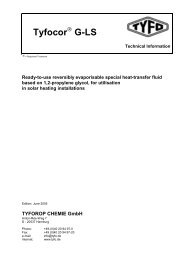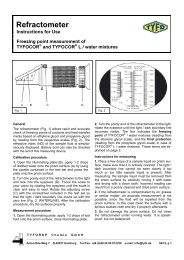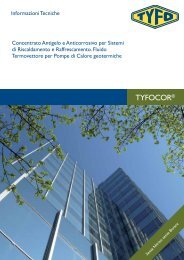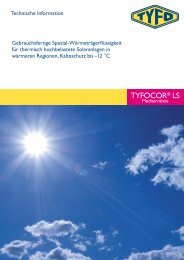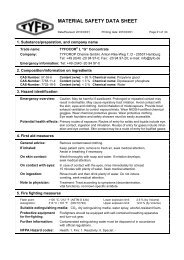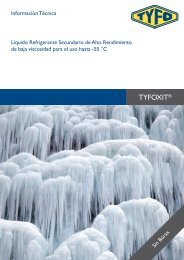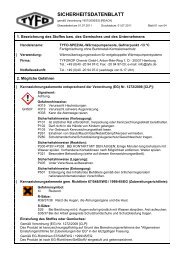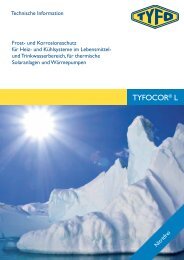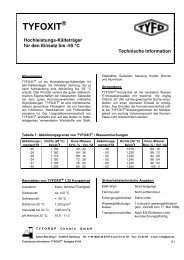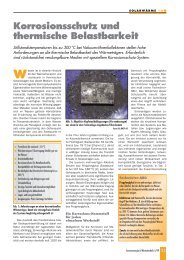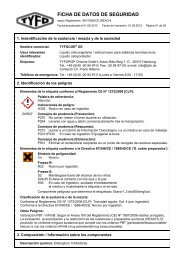Tyfocor L âGâ - Tyforop Chemie GmbH
Tyfocor L âGâ - Tyforop Chemie GmbH
Tyfocor L âGâ - Tyforop Chemie GmbH
You also want an ePaper? Increase the reach of your titles
YUMPU automatically turns print PDFs into web optimized ePapers that Google loves.
An important point to note is that the performance<br />
of elastomers such as EPDM is<br />
determined by the nature and amount of the<br />
constituent additives and the vulcanisation<br />
conditions, as well as the properties of the<br />
rubber itself. For this reason, we would recommend<br />
testing the resistance of these elastomers<br />
to mixtures of <strong>Tyfocor</strong> ® L “G” / water before<br />
they are put into service for the first time.<br />
Application guidelines<br />
We recommend to adhere to the following instructions<br />
to avoid premature aging of the fluid:<br />
1. Solar systems must be designed as closed<br />
circuits to minimize the access of atmospheric<br />
oxygen to the solar fluid. In presence of oxygen,<br />
propylene glycol undergoes oxidation to organic<br />
acids, which will shift the pH to values below 7.<br />
Metal corrosion is significantly accelerated<br />
under acidic conditions.<br />
2. Zinc will be removed by propylene glycol /<br />
water mixtures, hence neither heat exchangers,<br />
expansion tanks, pipes nor any other system<br />
component system must be galvanized.<br />
3. Silver or copper brazing solders are to be<br />
utilised preferably on joints. Soft solder fluxes<br />
usually contain chlorides. Their residues must<br />
be removed by thorough cleansing of the<br />
system, because chloride concentrations >100<br />
ppm in the solar fluid increase the risk of pitting<br />
corrosion on system components.<br />
4. Chemically speaking, aqueous solutions of<br />
propylene glycol are largely inert, but it is important<br />
to ensure that the manufacturer’s recommendations<br />
state that all the seals and<br />
connectors used in solar heating equipment are<br />
resistant to temperatures up to the maxi-mum<br />
static temperature of the system.<br />
5. Flexible connections / hoses must consist of<br />
metal or other materials which do not permit<br />
oxygen diffusion.<br />
6. The hydraulic layout of the system must<br />
ensure that fluid circulation cannot be disturbed<br />
by gas pockets or any deposits.<br />
7. The level of the solar fluid must never fall<br />
below the highest point in the system. An air<br />
bleed valve must be installed appropriately to<br />
allow accurate de-aeration / degasification. In<br />
case automatic air bleed valves are used it<br />
must be ensured that no air can be sucked in<br />
during standstill of the system.<br />
2<br />
8. Dirt and water must not be allowed to enter<br />
the system or its components during assembly<br />
and before filling. After the assembly has been<br />
completed and the connections have been<br />
soldered, the system must be flushed to remove<br />
any foreign matter (copper scale, rust<br />
swarf, fluxes, packaging residues, sawdust, etc)<br />
and material used during assembly as<br />
completely as possible. Subsequently, the system<br />
should be checked for leaks and drained<br />
completely afterwards. We recommend to fill<br />
the system with <strong>Tyfocor</strong> ® L “G” / water mixture<br />
immediately in order to prevent corrosion.<br />
9. It must be ensured that no air pockets remain<br />
in the installation after the filling. It is essential<br />
to eliminate any gas pockets, because a<br />
vacuum would form if they collapsed following a<br />
drop in operation temperature, and this would<br />
finally cause air to be sucked into the system.<br />
10. Provided in-circuit filter elements were installed,<br />
they must be cleaned within 14 days at<br />
the latest after the solar system was put into<br />
operation in order to ensure that no obstruction<br />
to the fluid flow may occur due to deposits in<br />
any part of the installation.<br />
11. In case a loss of solar fluid due to water<br />
evaporation occurs during operation, solely deionized<br />
or distilled water must be used to top up<br />
the system. If leakages or other losses oc-cur,<br />
the system must be replenished with <strong>Tyfocor</strong> ® L<br />
“G” / water mixture of similar content. The<br />
concentration can be checked by either<br />
measuring the density or the refractive index.<br />
Storage stability<br />
<strong>Tyfocor</strong> ® L “G” has a shelf life of at least three<br />
years in airtight containers. Do not store in galvanized<br />
containers, because zinc can be dissolved<br />
by propylene glycol / water mixtures.<br />
Handling, Health and Safety Information<br />
The usual safety and industrial hygiene measures<br />
relating to chemicals must be observed in<br />
handling <strong>Tyfocor</strong> ® L “G” / water mixtures.<br />
The information and instructions given in the<br />
Material Safety Data Sheet (MSDS) must be<br />
strictly observed. The MSDS is available by<br />
direct download at www.tyfo.de or can be requested<br />
per e-mail via info@tyfo.de.<br />
TYFOROP CHEMIE <strong>GmbH</strong><br />
Anton-Rée-Weg 7<br />
D - 20537 Hamburg<br />
Phone: +49-(0)40 20 94 97-0<br />
Fax: +49-(0)40 20 94 97-20<br />
e-mail: info@tyfo.de<br />
Internet: www.tyfo.de



